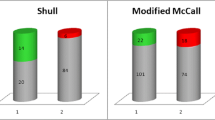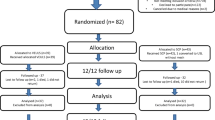Abstract
Introduction and hypothesis
The objective of this study is to assess anatomical and functional results of the extraperitoneal uterosacral ligament suspension (USL) in women with post-hysterectomy vaginal vault prolapse.
Methods
One hundred and twenty-three consecutive women were included. Concurrent procedures were anterior colporraphy with fascial repair (20%) and mesh reinforcement (49%), posterior colporraphy with fascial repair (38%) and mesh reinforcement (56%) and a sling procedure (29%). Women were assessed using Baden and Walker and pelvic organ prolapse quantification classification pre- and post-operatively.
Results
One hundred and ten patients (89%) were available for follow-up. Mean follow-up was 2 years. Objective success rate regarding the vaginal cuff is 95.4%. Global anatomical success rate was 85.5%. Urinary, coital and bowel symptoms were improved following surgery. Mesh exposure rate was 19.3%, with all cases managed conservatively or with minor interventions.
Conclusion
Bilateral extraperitoneal USL is an effective operation to restore apical support with low morbidity, which avoids potential risks associated with opening the peritoneal cavity.


Similar content being viewed by others
References
Marchionni M, Bracco GL, Checcucci V, Carabaneanu A, Coccia EM, Mecacci F, Scarselli G (1999) True incidence of vaginal vault prolapse. Thirteen years of experience. J Reprod Med 44:679–684
Arbel R, Lavy Y (2005) Vaginal vault prolapse: choice of operation. Best Pract Res Clin Obstet Gynaecol 19:959–977
Barrington JW, Edwards G (2000) Posthysterectomy vault prolapse. Int Urogynecol J Pelvic Floor Dysfunct 11:241–245
Beer M, Kuhn A (2005) Surgical techniques for vault prolapse: a review of the literature. Eur J Obstet Gynecol Reprod Biol 119:144–155
Maher CF, Qatawneh AM, Dwyer PL, Carey MP, Cornish A, Schluter PJ (2004) Abdominal sacral colpopexy or vaginal sacrospinous colpopexy for vaginal vault prolapse: a prospective randomized study. Am J Obstet Gynecol 190:20–26
Elghorori MR, Ahmed AA, Al-Taher H (2002) The risk of vaginal wall prolapse following sacro-spinous fixation. Int J Gynaecol Obstet 78:61–64
Meschia M, Bruschi F, Amicarelli F, Pifarotti P, Marchini M, Crosignani PG (1999) The sacrospinous vaginal vault suspension: critical analysis of outcomes. Int Urogynecol J Pelvic Floor Dysfunct 10:155–159
Sze EHM, Karram MM (1997) Transvaginal repair of vault prolapse: a review. Obstet Gynecol 89:466–475
Karram M, Goldwasser S, Kleeman S, Steele A, Vassallo B, Walsh P (2001) High uterosacral vaginal vault suspension with fascial reconstruction for vaginal repair of enterocele and vaginal vault prolapse. Am J Obstet Gynecol 185:1339–1342
Silva WA, Pauls RN, Segal JL, Rooney CM, Kleeman SD, Karram MM (2006) Uterosacral ligament vault suspension: five-year outcomes. Obstet Gynecol 108:255–263
Dwyer PL, Fatton B (2008) Bilateral extraperitoneal uterosacral suspension: a new approach to correct posthysterectomy vaginal vault prolapse. Int Urogynecol J Pelvic Floor Dysfunct 19:283–292
Jha S, Moran PA (2007) National survey on the management of prolapse in the UK. Neurourol Urodyn 26:325–331
Shull BL, Bachofen C, Coates KW, Kuehl TJ (2000) A transvaginal approach to repair of apical and other associated sites of pelvic organ prolapse with uterosacral ligaments. Am J Obstet Gynecol 183:1365–1373
Barber MD, Visco AG, Weidner AC, Amundsen CL, Bump RC (2000) Bilateral uterosacral ligament vaginal vault suspension with site-specific endopelvic fascia defect repair for treatment of pelvic organ prolapse. Am J Obstet Gynecol 183:1402–1410
Amundsen CL, Flynn BJ, Webster GD (2003) Anatomical correction of vaginal vault prolapse by uterosacral ligament fixation in women who also require a pubovaginal sling. J Urol 169:1770–1774
Montella JM, Morrill MY (2005) Effectiveness of the McCall culdeplasty in maintaining support after vaginal hysterectomy. Int Urogynecol J Pelvic Floor Dysfunct 16:226–229
Meeks GR, Washburne JF, McGehee RP, Wiser WL (1994) Repair of vaginal vault prolapse by suspension of the vagina to iliococcygeus (prespinous) fascia. Am J Obstet Gynecol 171:1444–1452
Shull BL, Capen CV, Riggs MW, Kuehl TJ (1993) Bilateral attachment of the vaginal cuff to iliococcygeus fascia: an effective method of cuff suspension. Am J Obstet Gynecol 168:1669–1674
Jenkins VR (1997) Uterosacral ligament fixation for vaginal vault suspension in uterine and vaginal vault prolapse. Am J Obstet Gynecol 177:1337–1343
Aigmueller T, Riss P, Dungl A, Bauer H (2008) Long-term follow-up after vaginal sacrospinous fixation: patient satisfaction, anatomical results and quality of life. Int Urogynecol J Pelvic Floor Dysfunct 19:965–969
Flynn BJ, Webster GD (2002) Surgical management of the apical vaginal defect. Curr Opin Urol 12:353–358
Cruikshank SH (1987) Preventing posthysterectomy vaginal vault prolapse and enterocele during vaginal hysterectomy. Am J Obstet Gynecol 156:1433–1440
Maher CF, Murray CJ, Carey MP, Dwyer PL, Ugoni AM (2001) Iliococcygeus or sacrospinous fixation for vaginal vault prolapse. Obstet Gynecol 98:40–44
Ridgeway B, Barber MD, Walters MD, Paraiso MF (2007) Small bowel obstruction after vaginal vault suspension: a series of three cases. Int Urogynecol J Pelvic Floor Dysfunct 18:1237–1241
Clark AL, Gregory T, Smith VJ, Edwards R (2003) Epidemiologic evaluation of reoperation for surgically treated pelvic organ prolapse and urinary incontinence. Am J Obstet Gynecol 189:1261–1267
Benson JT, Lucente V, McClellan E (1996) Vaginal versus abdominal reconstructive surgery for the treatment of pelvic support defects: a prospective randomized study with long-term outcome evaluation. Am J Obstet Gynecol 175:1418–1421
Dwyer PL, O’Reilly BA (2004) Transvaginal repair of anterior and posterior compartment prolapse with Atrium polypropylene mesh. BJOG 111:831–836
Fatton B, Amblard J, Debodinance P, Cosson M, Jacquetin B (2007) Transvaginal repair of genital prolapse: preliminary results of a new tension-free vaginal mesh (Prolift technique)—a case series multicentric study. Int Urogynecol J Pelvic Floor Dysfunct 18:743–752
Hiltunen R, Nieminen K, Takala T, Heiskanen E, Merikari M, Niemi K, Heinonen PK (2007) Low-weight polypropylene mesh for anterior vaginal wall prolapse: a randomized controlled trial. Obstet Gynecol 110:455–462
Achtari C, Hiscock R, O’Reilly BA, Schierlitz L, Dwyer PL (2005) Risk factors for mesh erosion after transvaginal surgery using polypropylene (atrium) or composite polypropylene/polyglactin 910 (Vypro II) mesh. Int Urogynecol J Pelvic Floor Dysfunct 16:389–394
Acknowledgements
We want to thank Dr. Bruno Aublet Cuvelier (Medical Information management Unit, University Hospital Clermont-Ferrand, France) for his contribution in the statistical analysis.
Conflicts of interest
None.
Author information
Authors and Affiliations
Corresponding author
Rights and permissions
About this article
Cite this article
Fatton, B., Dwyer, P.L., Achtari, C. et al. Bilateral extraperitoneal uterosacral vaginal vault suspension: a 2-year follow-up longitudinal case series of 123 patients. Int Urogynecol J 20, 427–434 (2009). https://doi.org/10.1007/s00192-008-0791-8
Received:
Accepted:
Published:
Issue Date:
DOI: https://doi.org/10.1007/s00192-008-0791-8




